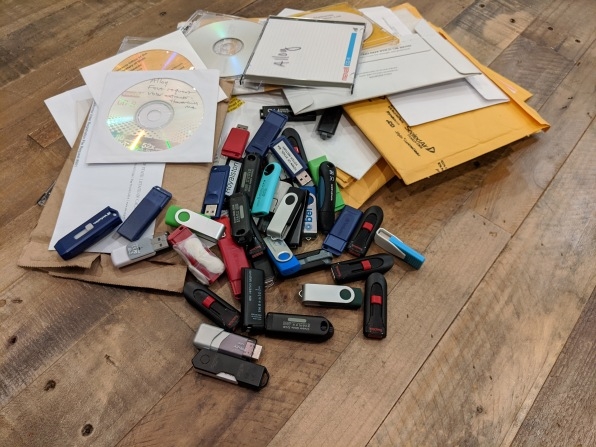Trump’s data team crushed Democrats in 2016. Can this small startup even the score?
Not far from the White House in Washington, D.C., a group of former Obama staffers are building a war room. Their new offices are still mostly empty—unopened boxes double as standing desks, and there are plans for an “office furniture assembly party”—but there’s a palpable excitement that fills the space. The startup’s founders have set an ambitious agenda: defeating Donald Trump and helping Democrats win races up and down the ballot in November.
Alloy, which is funded by LinkedIn billionaire Reid Hoffman, is part of a wave of pol tech companies that rose from the ashes of Hillary Clinton’s defeat in 2016. One of the more painful lessons from that debacle was the realization that the Democratic party had fallen behind the GOP in the science of campaigning. While Republicans used up-to-date voter data to knock on the right doors and dial the right numbers, the Clinton camp bemoaned the sorry state of the voter data file it received from the Democratic National Committee. To make matters worse, one insider told me, the system that served up the data crashed every couple of days.
For the mostly liberal enclave of Silicon Valley, it was a rude awakening. In the months after the election, venture capitalists and tech firms began committing money to building new tools to put Democratic candidates back on equal footing. One of the most active players guiding this progressive tech resurgence was Hoffman, who has spread cash among a number of campaigns, causes, and pol tech groups hungry for funding. In the 2018 midterms, his venture-fueled efforts were credited with helping Democrats win a number of key races. But Hoffman, who got his first taste of success as an early employee at PayPal, had his eye on something bigger. Rumors swirled in 2019 that Hoffman was funding a new company that would bring together some of the most talented political tech people to directly challenge the Republicans’ lead in voter intelligence and outreach data.

That company turned out to be Alloy, the creation of two known names in pol tech circles–ex-Obama staffers Haley Van Dyck and Mikey Dickerson. Both veterans of Obama’s campaign tech team starting back in 2009, Van Dyck and Dickerson reconnected during the troubled launch of Healthcare.gov (Dickerson took an unplanned hiatus from Google to help lead the turnaround) before joining forces to help build the U.S. Digital Service, an elite tech unit inside the White House led by the nation’s first Chief Technology Officer, Todd Park.
For Van Dyck and Dickerson, everything they worked on during the Obama years was put in jeopardy by Trump’s victory. “Once the election happened,” Van Dyck told me, “it was clear that the most existential threat to our democracy was Donald Trump, and that we needed to shift our attention upstream.”
In 2017 Dickerson formed a nonprofit called The New Data Project, which delivered a social get-out-the-vote app that was used by Democratic campaigns before the 2018 midterms. But a bigger problem remained. The DNC, state parties, and outside groups had fallen to infighting over voter data—in many ways the party’s most precious commodity. Insiders saw the value of consolidating voter information into a central data bank, as Republicans had done, but were at loggerheads over who should hold the keys to the vault.
Van Dyck and Dickerson couldn’t wait for the warring tribes. The following year, they came up with the plan for what became Alloy: an organization that could “contribute to true, lasting change in progressive data” by constructing the technological infrastructure to pool resources from Democratic groups across the country. Instead of building a vault, they would break down the barriers preventing people from sharing data.
It was perfect timing for Hoffman, who had been looking for a way to disrupt the status quo. “Once the plan was developed and had been shopped around, we called Todd Park, and within weeks he and Reid gave a generous seed round to fund the team now called Alloy,” Van Dyck said. Armed with a check for $35 million, they got to work.
Fighting the GOP data juggernaut
Van Dyck and Dickerson face stiff competition across the aisle. For decades, Democrats enjoyed a notable technological advantage over their Republican rivals. In 2012, the Obama camp dominated with its use of targeted digital advertising. But after that election, something changed. The Clinton campaign didn’t seem to possess the same spirit of technological innovation. Van Dyck said that in terms of the data and technology, not much improved between 2012 and 2016, despite the fact that private sector tech companies were making significant advances in their ability to identify, track, and communicate with prospective customers.
Meanwhile, the GOP was charging ahead. In 2011 the conservative mega-donors Charles and David Koch acquired and pumped money into a big data company called i360, which went on to gather political and consumer data on 270 million Americans. Using this central repository of voter data, GOP campaigns (and PACs, and nonprofit groups) can locate, persuade, and activate massive numbers of potential voters across media platforms. Republicans also swung into action to build a platform called the Data Trust, an RNC designated clearinghouse where all kinds of conservative campaigns and groups can access voter data information. One of the requirements for using the data is that individual candidates update the voter file with information they collect during their campaigns, to keep it as up to date as possible.

[Photo: courtesy of Alloy]
Van Dyck and Dickerson say they spent a lot of time studying the GOP’s Data Trust and the Koch-funded i360. Their intent is to build a Democratic version that borrows many of its virtues, like the ability for campaigns to borrow and enhance voter data sets. Alloy is building a decentralized, cloud-based platform that can serve voter data via secure APIs (application programming interface) to and among Democratic campaigns, state parties, advocacy groups, PACs, and trade unions. And it plans to provide access to the tools used to collect all that data–battle-proven canvassing and organizing tools, like the Hustle peer-to-peer texting app, and Reach, the canvassing app developed by the Alexandria Ocasio Cortez campaign in New York.
There will be a cost for campaigns and other organizations to tap into the data and apps at Alloy. Van Dyck says the company is now in conversation with its partners about exactly how that model will work, stressing that Alloy is a nonprofit trying to build a “progressive utility rather than a for-profit tech company.”
Dickerson says the platform will live on a cloud service like Amazon’s AWS, so that users can securely access the voter data and tools from anywhere.
One of the barriers to sharing data among Democratic groups is that they use different systems and data file types. Alloy will work behind the scenes to clean data and convert it into usable formats. If Alloy achieves nothing else, that accomplishment alone would contribute a lot to Democrats by eliminating a huge point of friction, says Dickerson.
“We’re trying to put all of the pain points of both the costs of doing this well, and the technical aptitude required to do it, onto our shoulders so that we can get both this data and these tools into the hands of as many people as possible in the progressive ecosystem,” Van Dyck said.
Solving the registration problem
Alloy’s vision, of course, will take time. The company has 35 employees right now, split between Washington and San Francisco, and expects to double that number by November. But the full spectrum of tech and services Alloy hopes to provide won’t all be ready for this year’s election. So Van Dyck and Dickerson are seizing on a specific role that might have the greatest near-term impact using the infrastructure they’ve already built: voter registration.

For reasons both accidental and not-so-accidental, Democratic voter registrations often go missing in elections around the country. Many new registrations are collected by voting organizations via email or mail-in campaigns, or via registration booths set up in malls or outside grocery stores. But there’s no good way to make sure that the registration actually gets accepted. While the voter registration lists are public record, there’s no API with which to access them. So Alloy’s people are now sending checks to secretaries of state (or county clerks, as the case may be), then waiting to receive the lists in the mail, on thumb drives or CDs.
It can be tedious work. Sometimes registration data comes in different file types or formats. Excel spreadsheets or other .csv files may have columns of data missing. So Alloy is doing the hard work of rationalizing and reconciling all this data, then providing a platform for registration organizations and would-be voters to confirm that registrations were processed successfully.
Silly things happen, like a registrar might decide that only black ink is acceptable for signatures on paper”
Mikey Dickerson, Alloy CTO
The end goal is to enable politicians and organizations to confirm the registration status of voters in any jurisdiction in the country, although Alloy is focusing first on swing states in order to have the greatest impact on the 2020 election.
If a voter registration doesn’t make it into the system or was rejected for some reason, Alloy can take action. “Silly things happen, like a registrar might decide that only black ink is acceptable for signatures on paper,” Dickerson told me. Such one-off problems might be addressed via a registration group or an individual. More complicated or endemic problems might require legal action by a voting rights group.
Alloy intends to use both approaches. “If we find that 20,000 of those ballots are being tossed out, we’d like to go find somebody to file the litigation to get those 20,000 accepted,” Dickerson said. “But at the exact same time, we might say if you’re going to see this person at church on Sunday anyway why not just have them sign another form in black ink and we’ll try that too.”
Maximizing Democratic registrations in swing states could make a real difference in the 2020 presidential election, which could come down to a small number of voters in a handful of states. In 2016, for example, Trump beat Clinton by just 22,748 votes in Wisconsin—a state where more than 1 million eligible voters were unregistered. Getting just 2.5% of them to the polls could have been a game changer.
Silicon Valley outsiders get a wary welcome
True to the Democratic Party’s penchant for infighting, its state parties, PACs, and the DNC have jousted over control of voter data. Silicon Valley types offering new political tech are often seen as outsiders who have no clue about party dynamics. There’s been some truth to that contention, as Hoffman has learned the hard way.
That knowledge has informed Alloy’s model. The motive question may be part of the reason that Alloy was set up as a nonprofit. Most importantly, Alloy employs a federated model that lets groups like state parties and PACs retain control over their voter files. “We’ve always thought of ourselves as a little different from Data Trust as it sometimes gets proposed, in that we never meant to appoint ourselves the deciders on who has access,” Dickerson said.

[Photo: courtesy of Alloy]
In Democratic politics, state party committees wield considerable power, and work in partnership with the DNC, including on technology issues. The state Democratic parties maintain their own data files, and they earn revenue by leasing the voter file to candidates or causes that want to campaign in the state.
Already, state party officials are skeptical that Alloy can succeed, expressing doubts about new tech solutions offered by people from outside the party structure. They’re also aware of the tech sector’s role in helping spread misinformation on their platforms in 2016, and of Facebook’s leakage of mountains of user data to the Trump-connected political data firm Cambridge Analytica.
“[T]he amount of times that I’ve heard Silicon Valley folks say that they have the best solution to all of our problems . . . if we just turned over all of our data to them, we’ll win elections,” said Jane Kleeb, chair of the Democratic Party in the deep red state of Nebraska.
Kleeb, and other state party chairs I interviewed, point out that state and national party organizations already have data sharing capabilities. Kleeb explained that the state parties run a “co-op” where they can make the voter data they’ve gathered available to campaigns, and get paid for it. Upon Alloy’s launch last year, some in the party expressed concerns about the involvement of Hoffman, who was forced to apologize for funding a group in Alabama that spread misinformation via Facebook about infamous Republican Senate candidate Roy Moore in 2017.
The amount of times that I’ve heard Silicon Valley folks say that they have the best solution to all of our problems…”
Jane Kleeb, Nebraska Democratic Party chair
After the 2016 election, the DNC also began beefing up its voter data infrastructure. It now aggregates all the voter data files from state committees, and makes it available (for a fee) to state or national campaigns. The data includes information on voters’ participation in previous elections, the issues those voters care about, and an array of demographic information, says DNC chief technology officer Nellwyn Thomas. Another DNC initiative, called the Democratic Data Exchange (DDEx), is also meant to mirror the GOP’s powerful Data Trust by providing a platform for Democratic campaigns and outside groups to access and share voter outreach data. According to Thomas, it’s already exchanged voter data with Democratic organizations in Kentucky and Virginia.
Like Alloy, it’s unlikely that DDEx will be fully operational before the election in November. The exchange aims to enable Democratic groups to access logistical information, such as the names of groups that have contacted specific households, and when. That could be critical in primary states and swing states where voters will be hearing from Democratic organizations a lot. But DDEx may not be ready to act as a central clearinghouse for deep data on each voter, such as the kind of conversations voters have had with specific canvassers or the individual issues they discussed.
Too many cooks in the kitchen?
Is there enough room in the tent for both groups, or will they compete with each other in a way that undercuts the goals of the party? For now, both organizations are being diplomatic. Thomas says she knows that Alloy will be focusing on voter registrations for the 2020 elections and believes that there’s always room for new ideas that might help Democratic campaigns spend their time, money, and resources more effectively.
The people at Alloy are at least partly aware of what’s happening within DDEx, and Dickerson says Alloy would rather work with them than in competition with them.
“There are several groups working to confront the common data challenges we face,” Dickerson wrote in a email, “and while there are long-standing conversations about how we might collaborate, our belief is that we are solving a different set of problems in a different way.”
Alloy’s pitch to state party and national party officials sounds like a hard sell right now, even with its assurances that it wants to be a “utility” and doesn’t intend to seize control of the party’s data. Then again, Alloy is just beginning its conversations with party officials. It’s possible that it could change minds by demonstrating the superior power of its platform in the voter registration work it’ll do throughout the year. Later on, it may prove that it can make campaigns more efficient and persuasive by circulating data faster, or help them leverage more data from PACs or labor unions, or ease FEC compliance burdens.
For now, party officials claim they’re not hostile to Silicon Valley types with big ideas for political tech, but they remain skeptical that their visions will become reality.
“Maybe they have some magic interface that will change a lot of ways that we’re able to call voter data and be able to win more elections for Democrats,” Kleeb told me. “And I think everybody’s always open to that.” But Kleeb’s open-mindedness is tempered by lingering concerns that tech groups like Alloy have some ulterior motive not connected to the fate of the party, or that they just won’t be around ten years from now.
Van Dyck and Dickerson are well aware of the complexities of Democratic politics. They’ve been around around the block, including the years they spent working in the Obama administration. At the same time, they sound more like tech-savvy activists than tech entrepreneurs in search of a niche.
“There’s a lack of resources across the board and a ton of people working on common goals,” Van Dyck said. “We’re trying to come in and identify that common ground, and recognize that as an ecosystem we can come together to really help modernize our entire movement, and now’s the time to do that.”
(21)



